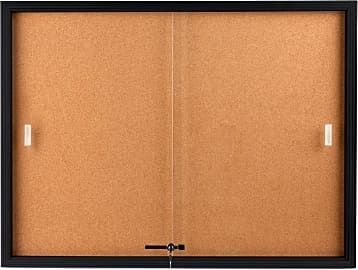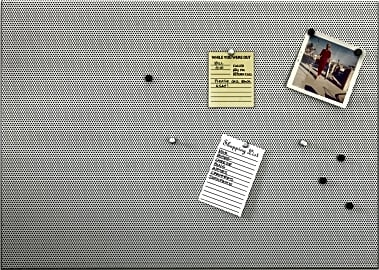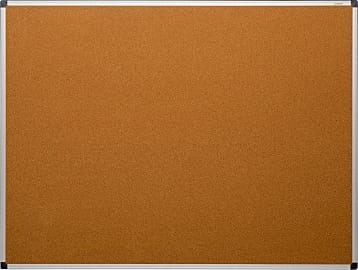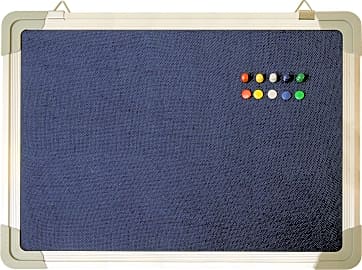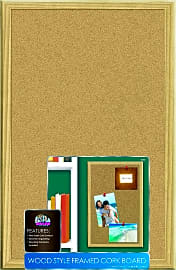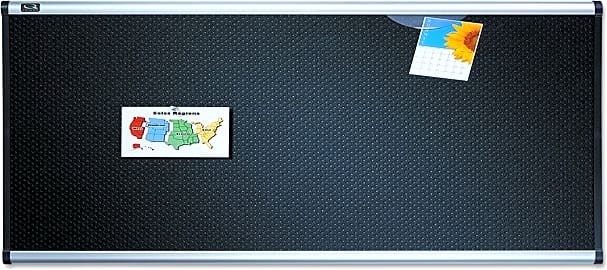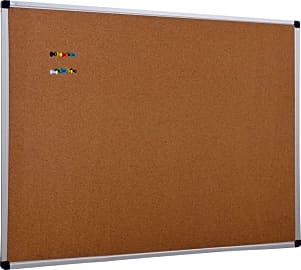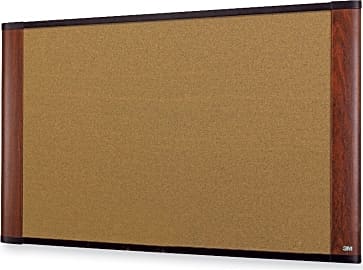The 10 Best Bulletin Boards

This wiki has been updated 38 times since it was first published in June of 2015. A high-quality bulletin board can serve several purposes. You can use one to keep notes and lists in one place, to share announcements with your employees, or as a nice home for family photos and artwork. Our selection includes a variety of options made from a wealth of materials, including cork, in many different sizes. They are suitable for bedrooms, kitchens and professional office settings. When users buy our independently chosen editorial choices, we may earn commissions to help fund the Wiki.
Editor's Notes
March 18, 2019:
The undeniably original appearance of the Umbra Trigon saw it ascend all the way to number two. It's also incredibly convenient that it can work with both magnets and push pins, so if you have kids around you can restrict yourself to the use of the former. The enclosed model from Displays2Go also climbed a bit thanks to the reliability and convenience of its sliding doors. The models by Quartet and 3M also slipped a bit due to performance issues in their materials and framing that other models don't seem to struggle with — even those with simple designs.
A Brief History Of The Bulletin Board
People have been posting signs in public places, both legally and illegally, for millennia.
People have been posting signs in public places, both legally and illegally, for millennia. Whether they be political bills, advertisements for businesses and products, or symbols of religious affiliation, humans have been trying to get their message across to others since the beginning of written language. Ancient Romans notified people of missing items and animals and endorsed causes and politicians by way of graffiti on the fronts of their homes, a precursor to the fliers and yard signs people put out today. But the bulletin board as we know it is a relatively modern invention.
The first blackboard came into being in the early 1800s, but it wasn't until 1924 that a Topeka, Kansas native named George Brooks patented the idea of sticking tacks into a thin sheet of cork as a way to post messages in public. His creation gained popularity around the world, and was expanded upon by several other inventors, including W.F. Lewis, who patented the first chalkboard-bulletin board hybrid in 1959.
Contemporary bulletin boards have moved far beyond the original cork design. They come in a wide variety of sizes, shapes, and materials, and some are actually quite sophisticated. You can find models with metallic surfaces that work with both magnets and tacks, and others are made of a self-healing foam that automatically fills in holes from push pins when they're removed. Some even have sliding glass doors that lock to prevent people from adding or removing messages.
While the bulletin board is a decidedly analog invention, it was also the inspiration for several digital platforms. In 1978, the first ever public dialup bulletin board system was developed by Ward Christensen and Randy Suess. Before the internet even existed, these systems allowed users to exchanges messages, and later versions were dedicated exclusively to uploading and downloading files. Today, Pinterest offers a modern-day twist on traditional bulletin boards where users can collect and share links and photos.
How A Big Sheet Of Cork Can Help You Organize Your Life
When most people think of bulletin boards, they probably envision elementary school classrooms, coffee shops, and college campuses. And, while you may not have any reason to post fliers or "for sale" signs in your own office or living room, there are plenty of other ways you can use a bulletin board to help you stay organized both at home and at work.
If you have kids, a bulletin board is a perfect place to showcase their accomplishments.
One of the most obvious ways to use a bulletin board is as a giant calendar and to-do list. When you put reminders of significant dates in plain sight, you're much less likely to forget that you have a meeting or a big test coming up. For families with hectic schedules, a bulletin board can be a great way to keep track of what everyone is doing. Divide up your board so that each person has their own area where they can pin permission slips, school lunch menus, wedding invitations, bills, and other important forms and memos. This way, it's easy to stay on top of upcoming events and due dates, and leave notes for family members or roommates.
If you have kids, a bulletin board is a perfect place to showcase their accomplishments. Hang up medals, awards, and artwork that they're proud of, along with tests and assignments on which they did particularly well. They can also pin up photos of their friends and ticket stubs from movies, concerts, and other fun events they've attended.
Meal planning is another area where bulletin boards shine. Create a section for each day of the week and make index cards for all the dishes you cook on a regular basis. Then, you can simply pin your menu up at the beginning of each week. Planning ahead makes grocery shopping easier, eliminates the stress of deciding what to cook, and prevents your kids (and significant other) from constantly asking, "What's for dinner?"
You can even use a bulletin board as a homemade jewelry organizer. Push pins can hold necklaces, bracelets, and dangly earrings. It's not only cheaper than most jewelry boxes, it also allows you to position the tacks anywhere you want to accommodate pieces of varying lengths.
Make It Your Own: Ways To Personalize Your Bulletin Board
One of the easiest ways to spruce up a boring bulletin board is to put it in a nice frame. You can put your board into an open-backed frame if you're able to find one that will fit it. If not, washi tape is a quick and easy way to create an attention-grabbing border, and it comes in hundreds of patterns and prints, including some that look like real wood.
Or, if you don't feel like putting in the effort, you can buy push pins in a variety of fun shapes and themes, including flowers, animals, and even food.
Cork matches almost anything, but it doesn't look particularly exciting. To add a decorative touch that ties into your home or office decor, you can cover your bulletin board with fabric or wrapping paper. Simply find a color or pattern you like, cut it to about two to three inches larger than the board on all sides, fold it over the edges, and use a stapler or hot glue gun to attach it to the back side. You can also paint over the cork to create your own custom design, or use chalkboard paint to make a bulletin board that you can write on.
Themed boards are great for kids' bedrooms. Let them choose a favorite activity, sport, animal, or cartoon character and decorate their bulletin board using paper cutouts or stencils that fit the motif. Most craft stores will also carry borders to match almost any theme your little one can dream up.
If you really want to go all out, there are several ways you can customize your thumb tacks, as well. Gluing wooden clothespins to your tacks makes it easy to pin up photos or documents without putting holes in them. Wine corks, buttons, fake gemstones, Lego pieces, and just about anything else with a flat back can also be glued onto tacks. Or, if you don't feel like putting in the effort, you can buy push pins in a variety of fun shapes and themes, including flowers, animals, and even food.



